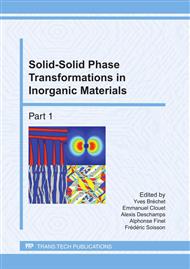[1]
H. S. Nayar, B. Wasiczko, Metal Powder Report 45, 611 (1990).
Google Scholar
[2]
M. C. Baran, A. E. Segall, B. A. Shaw, H. M. Kopech, T. E. Haberberger, Adv. in Powder Met. and Particulate Materials, Chicago IL 1997, 1, 37-42.
Google Scholar
[3]
K. T. Kim, Y. C. Jeon, Materials Science and Engineering A 245, 64 (1998).
Google Scholar
[4]
J. M. Capus, Advanced Materials and Processes 158, 57 (2000).
Google Scholar
[5]
P. K. Samal, Key Engineering Materials 189-191, 328 (2001).
Google Scholar
[6]
R. M. German, K. A. D'Angelo, Int. Met. Rev. 29, 249 (1984).
Google Scholar
[7]
M. Sarasola, T. Gómez-Acebo, F. Castro, Acta Mat., 52, 4615 (2004).
Google Scholar
[8]
K. Koichu, N. Mitsuru, H. Hiroshi, Funtai Oyobi Fummatsu Yakin/J. of the Jpn. Soc. of Powder and Powder Met. 47, 1091 (2000).
Google Scholar
[9]
K. S. Narasimhan, Materials Chemistry and Physics 67, 56 (2001).
Google Scholar
[10]
D. S. Madan, The Int. J. of Powder Met. 27, 339 (1991).
Google Scholar
[11]
P.E. Busy, M. E. Warga, C. Wells, J. of Metals Trans. AIME Nov., 1463 (1953).
Google Scholar
[12]
B. Hallemans, P. Wollants, J. R. Roos, Z. Metallkunde 85 (10), 676 (1994).
Google Scholar
[13]
S. K. Jensen, E. Maahn, World Cong. on PM, Paris 1994, 3, 2113-2116.
Google Scholar
[14]
A. Molinari, G. Straffelini, T. Pieczonka, J. Kazior, Int. J. of Powder Met. 34, 21 (1998).
Google Scholar
[15]
P. K. Samal, J. B. Terrel, Int. Conf. on Powder Met. & Particulate Materials, New York 2000, 7, 17-31.
Google Scholar
[16]
T. Pieczonka, J. Kazior, A. Tiziani, A. Molinari, J. of Mats. Proc. Technol. 64, 327 (1997).
Google Scholar
[17]
C. Schade, J. Schaberl, S. N. Thakur, V. C. Dongre, Int. Conf. on Powder Met. & Particulate Mats., Montreal (2005).
Google Scholar
[18]
L. Lozada, F. Castro, Adv. in Powder Met and Particulate Mater. 5, 129 (2008).
Google Scholar
[19]
C. Tojal, T. Gómez-Acebo, F. Castro, Materials Science Forum 534-536, 661 (2007).
DOI: 10.4028/www.scientific.net/msf.534-536.661
Google Scholar
[20]
R. M. German, The Int. J. of Powder Met and Powder Technol. 19, 277 (1983).
Google Scholar
[21]
R. Tardon, R. M. German, Int J Powder Metall 34, 40 (1998).
Google Scholar
[22]
J. Kazior, M. Nykiel, T. Pieczonka, T. Marcu Puscas, A. Molinari, Journal of Materials Processing Technology 157-158, 712 (2004).
DOI: 10.1016/j.jmatprotec.2004.07.140
Google Scholar
[23]
H. Danninger, G. Jangg, M. Giahi, Mat. -wiss. u. Werkstofftech 19, 205 (1988).
DOI: 10.1002/mawe.19880190607
Google Scholar
[24]
M. Sarasola, S. Sainz, F. Castro, Euro PM2005, Prague 2005, 1, 349-356.
Google Scholar
[25]
T. Gómez-Acebo, M. Sarasola, F. Castro, Calphad 27, 325 (2003).
Google Scholar
[26]
Y. Yang, Y. A. Chang, Intermetallics 13, 121 (2005).
Google Scholar
[27]
M. Morishita, S. K. Koyama, Yagi, G. Zhang, J. Alloys and Compounds 314, 212 (2001).
Google Scholar
[28]
V. G. Kudin, V. A. Makara, Inorganic Materials 3(3), 216 (2002).
Google Scholar
[29]
L. M. Pan, PhD thesis, Univ. of Surrey (1992).
Google Scholar
[30]
C. E. Campbell, U. R. Kattner, Calphad 26(3), 477 (2002).
Google Scholar
[31]
J. O. Anderson, B. Sundman, Calphad 11, 83 (1987).
Google Scholar
[32]
M. Hillert, C. Qui, Met. Trans 22A, 2187 (1991).
Google Scholar
[33]
H. L. Lukas, S. G. Fries, B. Sundman, Computational thermodynamics: The Calphad Method, Cambridge University Press (2007).
DOI: 10.1017/cbo9780511804137
Google Scholar


